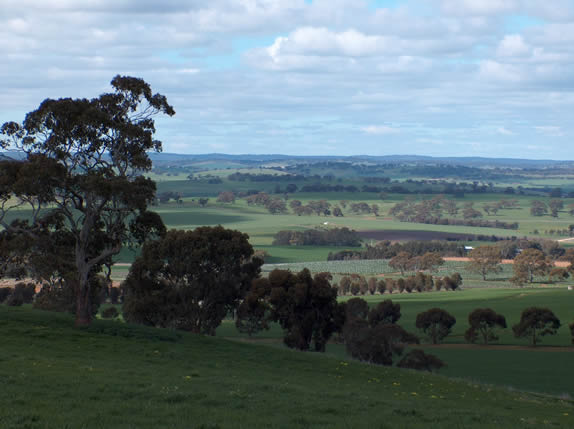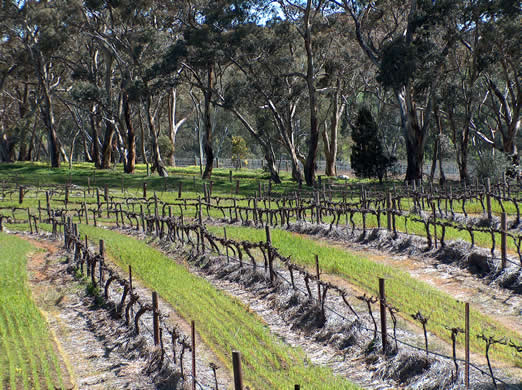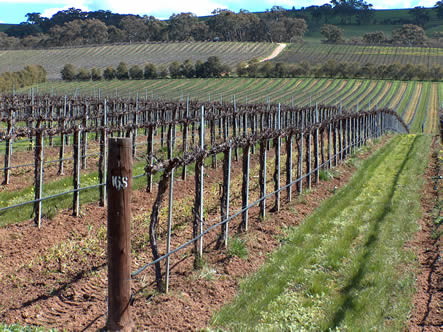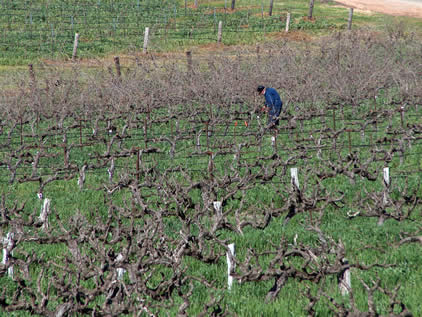|
The
Clare Valley
Part 1:
introduction

I
don’t think it would be mean to say that South Australia’s
Australia’s Clare Valley doesn’t have a terribly high profile,
as wine regions go. Of course, most wine geeks will have heard about
it, but few will be able to place it, or name more than a couple of
its wineries.
But
the Clare was thrust into the international spotlight in 2000, when
it briefly assumed the mantle of champion of the screwcap. Clare
winemakers, frustrated by the poor performance of cork, banded
together to make a stand on the issue.
Clare
is famous for its Rieslings, and these wines are made in a style
that shows up any cork-related faults particularly transparently.
The Clare winemakers had to overcome a significant logistical
obstacle before they could offer their wines in screwcap: at the
time, there was no Australian supplier who could offer bottles and
caps of the required  style
and quality. As a result, they had to drum together enough
like-minded producers willing to adopt screwcaps to generate an
order for 250 000 bottles from Pechiney in France, which was the
threshold needed to make this possible. style
and quality. As a result, they had to drum together enough
like-minded producers willing to adopt screwcaps to generate an
order for 250 000 bottles from Pechiney in France, which was the
threshold needed to make this possible.
With
a collaborative effort, they managed it, and the combined shift was
large enough to make headlines, for what at the time seemed a very
brave move. Jeffrey Grossett, one of the winemakers involved,
estimates that from this humble beginning, during the 2004 vintage
200 million wine bottles will be sealed with screwcaps in Australia,
roughly 10% of the entire Australian production. The Clare
initiative started the ball moving, and prompted the New Zealand
winemakers to form the NZ
Screwcap Initiative a year later.  ‘We
were inspired and encouraged by the success of the Clare Valley
Riesling move to screwcaps in 2000’, reports one of the founder
members, Michael Brajkovich MW of New Zealand’s Kumeu River Wines,
‘and like them we realized that we could achieve much more with a
combined effort than we could ever do individually.’ So Clare has
handed the baton on to the New Zealand guys, although screwcaps are
increasingly being used for reds here and not just Rieslings. ‘We
were inspired and encouraged by the success of the Clare Valley
Riesling move to screwcaps in 2000’, reports one of the founder
members, Michael Brajkovich MW of New Zealand’s Kumeu River Wines,
‘and like them we realized that we could achieve much more with a
combined effort than we could ever do individually.’ So Clare has
handed the baton on to the New Zealand guys, although screwcaps are
increasingly being used for reds here and not just Rieslings.
Aside
from its contribution to the closures debate, Clare is also home to
some very smart wines indeed. My visit was prompted by an email from
Andrew Mitchell, one of the leading Clare producers, who found out I
was visiting South Australia. He invited me to stay for a night and
take a look around, and I was happy to oblige.
 I
drove up on Sunday morning from the Barossa. It isn’t far; a
gentle drive through attractive farming country, taking an hour or
so. Once you are there, the Clare’s quite an easy place to get
your head around because it isn’t too big; while it’s not
strictly a single valley (it’s more like a couple, with gentle
rolling hills separating them), most of the action is signposted and
reachable from a single road, running right through the middle of
things. There’s also a nice walking route, well signposted, called
the Riesling trail. If you fancy a nice weekend in wine country, you
could do far worse than target Clare… I
drove up on Sunday morning from the Barossa. It isn’t far; a
gentle drive through attractive farming country, taking an hour or
so. Once you are there, the Clare’s quite an easy place to get
your head around because it isn’t too big; while it’s not
strictly a single valley (it’s more like a couple, with gentle
rolling hills separating them), most of the action is signposted and
reachable from a single road, running right through the middle of
things. There’s also a nice walking route, well signposted, called
the Riesling trail. If you fancy a nice weekend in wine country, you
could do far worse than target Clare…
Some
history. The first vines were planted in Clare in 1850 at Sevenhill,
and a number of wineries were established at this time. Another
burst of activity occurred in the 1890s, when more wineries –
including Wendouree – sprung into action. Leasingham (then known
as The Stanley Wine Company) was established in the 1920s, and then
nothing much happened until the 1960s, when there was another surge
of interest, and in the late 1960s and early 1970s more wineries
popped up. Things seem to be buzzing here now (in a laid back, Clare
sort of way).
I
was only here for a couple of days, so this will be just the
briefest sketch of the Clare. I visited Grosset, Mitchell and
Wendouree. It's on my list of places to revisit.
Back
to top
|

